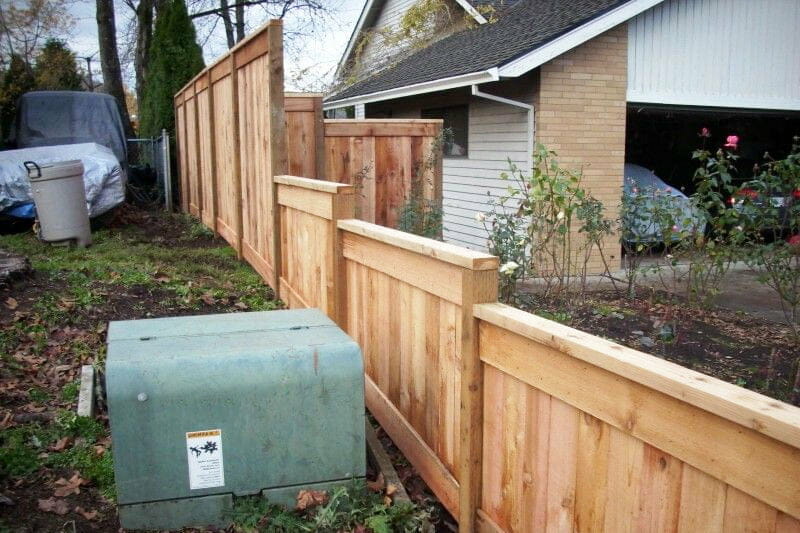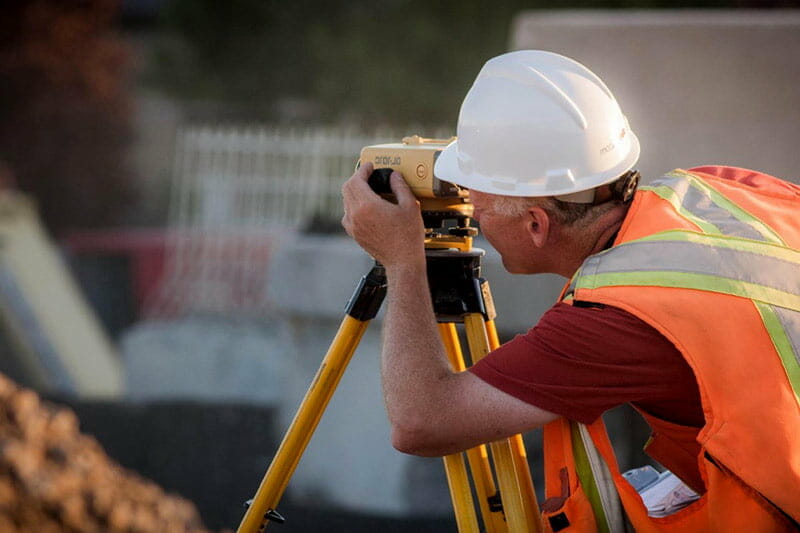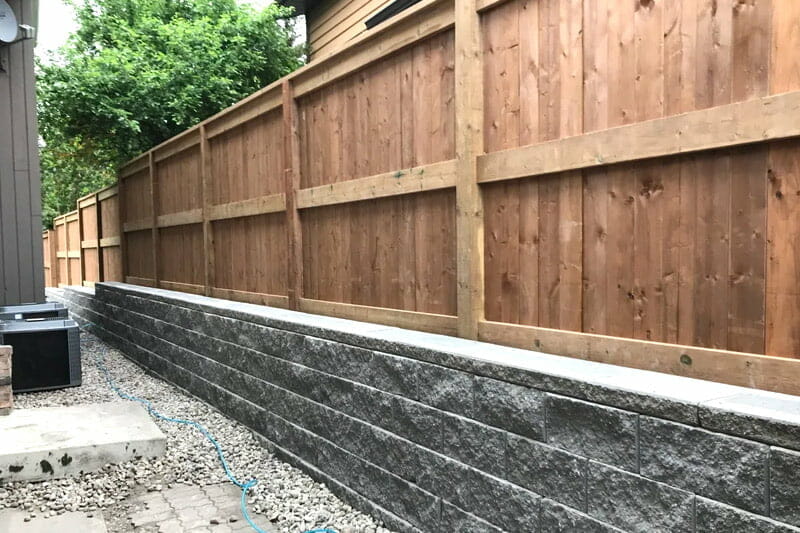As Robert Frost so fondly said, “good fences make good neighbors.” Unfortunately, fences are also a major cause of discourse and dispute among said neighbors.
Many homeowners assume that they own the left side of their property fence. However, fence ownership is determined by the position of a fence on the property line. Thus, in case the fence between houses is right on the property line, then none of you owns the fence.
Knowing who owns the fence is an all-important question, especially when determining who’s responsible for maintaining the fence or who pays for repairs in the case uncovered perils damage the fence.

How To Determine Who Owns the Fence
There are various ways you can determine fence ownership. Some are easy and free, like using your eyes, while others, like hiring a surveyor, need you to part with several dollars.
Hire a Surveyor
A surveyor is a sure way of establishing your property line boundaries. They can help to define boundary lines by uncovering the ground pins on each property.
Surveyors use a metal detector to determine the exact position of the ground pins, which are iron rods about 6 to 10 inches below the ground. A licensed land surveyor initially places the pins as they draw property lines.
Neighbors share responsibility and ownership of a fence if the surveyor finds that it lies on a shared property line or in an unoccupied space between two properties. The surveyor leaves you with a survey report which you should store well for future reference.
Determine Occupancy and Enclosure
Another way to determine fence ownership is by figuring out who uses the land closest to the fence. For example, the fence is yours by occupancy if you have grass or other plants on your side and are keen to take care of them while your neighbor neglects their side.
You can also be declared the owner of the fence if it’s attached to buildings and other structures, such as dog-run fences, on your property. Additionally, the fence is yours if it encloses your land completely instead of enclosing your neighbor’s property.
However, ownership and responsibility are shared if both property owners use the fence or have structures and buildings attached to it.
Locate It in Writing
The best way to determine fence ownership is to locate it in writing.
How? Find the T-mark on your transfer deed or conveyance deed. The T-mark is used to indicate boundary structure, responsibility, or right of ownership; hence, if the T-mark is on your property, then you own the fence and are responsible for any maintenance or repairs.
If there is an H-mark (two Ts joining at the boundary line) instead, then both you and your neighbor own the fence, and responsibility is split equally among both of you.
You will need to be keen when establishing the boundaries since they may be altered. For instance, if a neighbor has been consistently using a property for more than 12 years, then the beginning and the end of the boundary line may be changed permanently.
Search the Registry of Deeds
If the deeds do not show the actual boundaries, you have to search for the exact dimensions of your property from the land registry. There is normally a small fee that is charged for the boundary search.
Please note: Unregistered land may not appear in the land registry’s entries. Fortunately, there is a written summary of unregistered land documents found in the land registry.
Use Your Eyes
It is easy to tell who owns a fence by simply looking at the frames. Typically, walls and fences are built on the owner’s property, with the further edge defining the property boundary.
However, if the fence is right on the property line separating the two houses, neither of you owns the fence. So, in this case, the fence is a shared responsibility.
Another hint is that most fence installers often erect fences with the ‘bad side’ facing the property owners and the ‘good side’ facing the neighbors. Thus, you can use these unofficial methods to determine fence ownership fast.

How to Prevent Fence Ownership Issues
Disputes between neighbors can get ugly. Therefore, it’s important to avoid any kind of conflict that may arise between you and your neighbors.
Research Before You Buy
Property checks are an ideal way of verifying what you are purchasing. These ensure that you understand the property lines on the newly acquired property.
The property deeds also help determine a property’s boundaries and reveal which fence is allocated to which street. If you are still unsure, try checking on similar properties along the same side of the street.
Talk to Your Neighbors
A good way of avoiding misunderstandings concerning the boundaries between houses is by talking to your neighbor. In addition, talking helps to establish the concerns that your neighbor may have concerning fencing.
Through amicable conversations, you can negotiate on terms such as who owns the fence, who’s responsible for repairs and maintenance. You could also talk to your neighbor about establishing property lines and agree on the responsibilities each one of you will take on if it’s determined that you co-own the fence.
Involve Mediators
When prevening the dispute is impossible and you end up with conflicting conclusions, you may need to solve the problem.
Mediation is an effective dispute resolution method you can use when you can’t reach an amicable conclusion about who owns the fence.
Mediators are neutral parties who listen to both sides of the dispute and help resolve the property line dispute when you and your neighbor can’t reach an agreement. It is an affordable and peaceful method of dispute resolution that we highly recommend.
File a Lawsuit
Filing a lawsuit should be your last card when all other dispute prevention and resolution methods have fallen short. It costs thousands of dollars, drags on for too long, and could breed hate between you and your neighbor. That’s why we insist on taking this as a last resort. You can increase your chances of winning the case against your neighbor by arming yourself with an experienced property dispute lawyer.
Who Is Responsible for the Maintenance and Repair?
Fences have to be constantly maintained to maintain the curb appeal of a property.
The property laws stipulate that for jointly owned boundary fences, the owners’ cost-share the fence installation, repair, and maintenance costs since both parties benefit from the fence.
However, when the fence is installed on either side of the property lines, the fence is considered personal property. Thus, the landowner where the fence is installed pays for the installation, repair, and maintenance costs.
Your neighbor is liable to pay repair costs if they happen to damage the fence in all scenarios, when they own it, when you own it, and when the fence is jointly owned. Therefore, damaged fences are a major cause of dispute, and failure to understand the property boundaries and who owns the fence makes the situation worse.

FAQ’s
Who gets the good side of the fence?
There is no regulation as to who gets which side of the fence. The ideal situation would be to erect a fence that has no bad side.
However, this ideal situation is rare, and the common practice is to install a fence with the good side facing your neighbor. Then, you can swap sides after 10-20 years when the fence needs an overhaul.
Do I own the left side of the fence?
There is a common misconception that households are responsible for maintaining and repairing the fence to the left of their home. Although this is possible, it is not entirely true because you are generally responsible for maintaining every boundary surrounding your property.
Can I make changes to my neighbor’s fence?
The simple answer is; not without your neighbor’s permission. It is against fencing etiquette to make any changes to your neighbor’s fence without consulting them first. These changes include painting, leaning heavy furniture pieces, or hanging items from the fence.
It’s unlikely that your neighbor will say no, but doing it against their will or without their knowledge could land you in court. What’s more, if the changes you make damage the fence, you are liable to all related repair costs.
How close can my fence be to my neighbors?
The 4-inch rule states that you can build a fence up to the boundary line without the need for seeking permission. However, it is important to confirm the fencing laws or restrictions set by your city, municipal, or HOA before building the fence.







